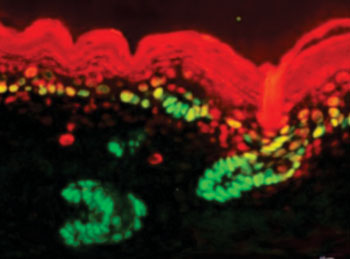Alternate Splicing Proteins Critically Linked to Skin and Organ Development
By LabMedica International staff writers
Posted on 07 Oct 2015
Two proteins that regulate alternative splicing in epithelial cells have been linked to the proper development of the skin and protective layers that surround other organs in the body.Posted on 07 Oct 2015
Two steps are required for genes to manufacture their protein products. The first, transcription, produces an intermediate RNA molecule or "transcript"; the second step, translation, turns the transcript into a protein. Most genes in mammals contain stretches of DNA called exons, which code for protein, interspersed with sequences called introns that do not. Therefore, a transcript must be "spliced" before translation—the introns are removed and the exons joined. In some genes, certain exons can be optionally included or excluded from a transcript to produce different versions of the same protein that can often have very different functions. This is known as alternative splicing, and is essential for normal development.

Image: Micrograph showing immunofluorescence of skin differentiation markers for basal keratinocytes (Photo courtesy of Dr. Russ Carstens, University of Pennsylvania).
Esrp1 (epithelial splicing regulatory protein 1) and Esrp2 (epithelial splicing regulatory protein 2) are two closely related proteins that regulate alternative splicing in epithelial cells. These specialized cells form sheets that line most organs in the body and are found in the epidermis, the outermost layer of the skin. Although Esrp1 and Esrp2 have previously been studied in the laboratory using cultured cell lines, their roles have not been investigated in living animals.
In a study published in the September 15, 2015, online edition of the journal eLife, investigators at the University of Pennsylvania (Philadelphia, USA) described experiments performed with lines of mice genetically engineered to lack the genes for either Esrp1, Esrp2, or for both proteins.
They found that mice that only lacked Esrp1 developed a cleft lip and palate. In mice that lacked both proteins, many organs failed to develop correctly and in some cases did not form at all. In the epidermis, the loss of Esrp1 and Esrp2 disrupted the splicing of the transcripts from genes that give epithelial cells many of their specialized characteristics, such as the ability to form sheets of cells with well-formed junctions between them. Thus, epidermis comprising cells that lacked Esrp1 and Esrp2 could not form a proper barrier layer, which is a crucial role of epithelia in skin as well as in other organs.
"Clearly there are many important roles for these genes in facial, skin, and organ development and we are only just starting to catalogue them," said senior author Dr. Russ P. Carstens, associate professor of medicine and genetics at the University of Pennsylvania. "The Esrp1-knockout mice will prove to be a valuable new model for studying cleft lip. There have been many knockout mouse models of cleft palate, but very few of cleft lip, which is actually the more common defect in humans."
Related Links:
University of Pennsylvania









 assay.jpg)



